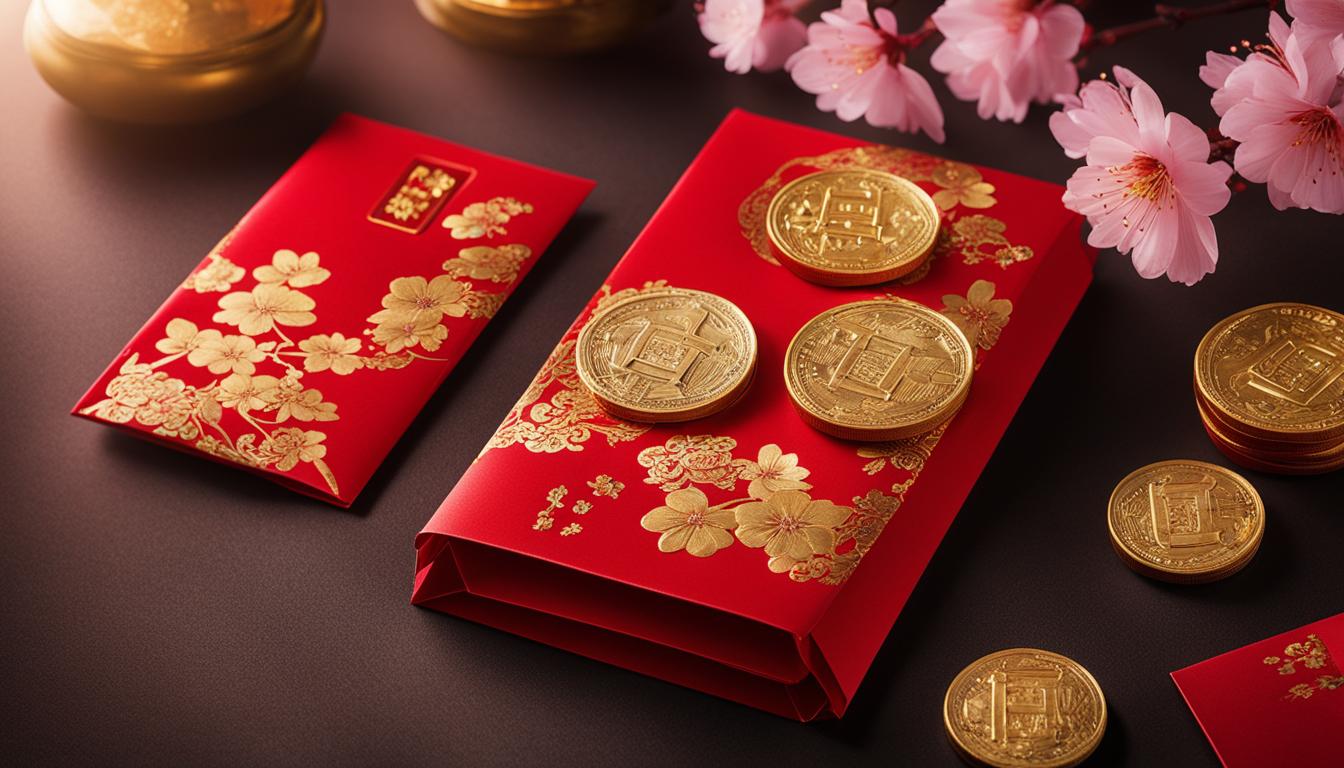Are you curious about the tradition of giving red envelopes filled with money for Chinese New Year? Wondering if you can include Chinese good luck coins in these festive envelopes? Let’s explore this popular New Year tradition and discover the significance behind red envelopes in Chinese culture.
Contents
- 1 The Significance of Red Envelopes in Chinese Culture
- 2 The Origin and Meaning of Red Envelopes
- 3 Who Should Give and Receive Red Envelopes
- 4 Tips for Giving and Receiving Red Envelopes
- 5 Other Occasions for Red Envelopes
- 6 Conclusion
- 7 FAQ
- 7.1 Can I give Chinese good luck coins in a red envelope for the New Year?
- 7.2 What is the significance of red envelopes in Chinese culture?
- 7.3 What is the origin and meaning of red envelopes?
- 7.4 Who should give and receive red envelopes?
- 7.5 Are there any tips for giving and receiving red envelopes?
- 7.6 Are red envelopes only given during Chinese New Year?
- 7.7 What is the significance of red envelopes in Chinese customs?
- 8 Source Links
Key Takeaways:
- Giving red envelopes with money is a common practice during Chinese New Year and other special occasions.
- Red envelopes symbolize good luck and blessings for the recipient.
- The tradition of red envelopes originated from ancient legends and has evolved to represent prosperity and well-wishes.
- Married adults typically give red envelopes to unmarried children and younger relatives.
- When giving or receiving red envelopes, it is important to observe etiquette and show gratitude.
The Significance of Red Envelopes in Chinese Culture
In Chinese culture, red envelopes hold great significance as they are considered lucky charms and symbols of good luck. The act of giving red envelopes, also known as hongbao or lai see, is deeply rooted in tradition and is a way to send good wishes and blessings to loved ones.
Red envelopes are typically decorated with beautiful Chinese calligraphy and symbols that convey positive messages and auspicious meanings. These symbols may include images of dragons, phoenixes, flowers, or the Chinese character for luck. The vibrant red color of the envelope itself is believed to ward off evil spirits and bring energy and happiness.
When receiving a red envelope, it is customary to accept it with both hands as a sign of respect and gratitude. The envelope is not opened in the presence of the giver but is instead opened in private to preserve the element of surprise and good luck.
The Symbolism of Red Envelopes
Red envelopes are not only a form of monetary gift but also a representation of the giver’s well-wishes and blessings for the recipient. The act of giving a red envelope signifies the strengthening of relationships and the desire for prosperity and happiness in the new year or on special occasions.
Other Good Luck Symbols in Chinese Culture
“In addition to red envelopes, Chinese culture is rich in other symbols of good luck and fortune. Some popular examples include:
- The Chinese character for luck, 福 (fú), which is often displayed upside down to symbolize the arrival of luck and happiness.
- The Chinese knot, a decorative knot made from a single piece of string, representing unity, love, and good luck.
- The color gold, which is associated with wealth, prosperity, and success.
These symbols, including red envelopes, serve as reminders of the importance of positive energy, blessings, and fortune in Chinese culture.”
The Origin and Meaning of Red Envelopes
Red envelopes have a rich history rooted in ancient Chinese legends and traditions. The practice of giving red envelopes during Chinese New Year dates back centuries and is believed to bring good luck and prosperity. One popular legend tells the story of a demon named Sui who terrorized children on New Year’s Eve. The demon was afraid of the color red and loud noises, so parents began to put coins in red envelopes and hang them on the walls to protect their children. Over time, this evolved into the tradition of giving red envelopes as a symbol of good luck.
Chinese New Year, also known as the Spring Festival, is the most important holiday in Chinese culture. It marks the beginning of the lunar calendar and is celebrated with family gatherings, feasts, and various customs. Giving red envelopes is an integral part of the festivities. The envelopes are typically filled with money, symbolizing wealth and blessings for the recipient. The amount of money inside the envelope is often considered lucky, and even numbers are preferred.
“The tradition of giving red envelopes during Chinese New Year has a deep cultural significance. It represents the desire to share good fortune with loved ones and to wish them a prosperous year ahead.” – Chinese Culture Expert
Red envelopes are not only given during Chinese New Year but also on other special occasions such as weddings, birthdays, and the birth of a baby. These envelopes are a way to convey good wishes and blessings to the recipients. The design and decorations on the envelopes may vary depending on the occasion, adding a personal touch and symbolism.
| Occasion | Symbolism |
|---|---|
| Chinese New Year | Good luck and prosperity for the new year |
| Weddings | Wishes for a happy and prosperous marriage |
| Birthdays | Celebrating another year of life and wishing for longevity |
| Birth of a baby | Blessings for a healthy and prosperous future |
The tradition of giving and receiving red envelopes is deeply ingrained in Chinese culture and continues to be practiced today. It is a meaningful gesture that embodies the spirit of generosity and well-wishes for loved ones. Embracing this tradition allows individuals to participate in the rich customs of Chinese culture and spread joy and prosperity in the new year.

The Meaning Behind the Red Envelope Tradition
Red envelopes are deeply rooted in Chinese culture and carry significant symbolism. The color red is associated with energy, happiness, and good luck. The act of giving red envelopes represents the sharing of good fortune and blessings. It is believed that the money inside the envelope will bring prosperity and abundance to the recipient in the coming year. By giving red envelopes, individuals express their wishes for a joyful and prosperous future for their loved ones.
Who Should Give and Receive Red Envelopes
Red envelopes are an integral part of Chinese New Year celebrations, symbolizing good luck and blessings for the recipient. Understanding the proper etiquette for giving and receiving red envelopes is important to fully embrace this cultural tradition. Red envelopes are typically given by married adults to unmarried children and younger relatives. Parents and grandparents also give red envelopes to their children and grandchildren as a way to bless them with good luck and prosperity. It is customary to receive red envelopes with both hands and to express gratitude.
The red envelope etiquette extends to the amount of money inside the envelope as well. While the specific amount may vary depending on personal preference and financial capability, it is customary to give money in even numbers, as odd numbers are considered unlucky in Chinese culture. The amount of money inside the envelope should be given according to the relationship with the recipient. Close family members may give a larger amount, while friends and distant relatives may give a smaller amount.
“When receiving a red envelope, it is polite to accept it with both hands and express gratitude.”
Red envelope giving and receiving is not just limited to Chinese New Year. Red envelopes are also exchanged during other special occasions such as birthdays, weddings, and the birth of a baby. The significance and etiquette of red envelopes remain the same, conveying good luck and blessings to the recipient. The design and decoration of the red envelopes may vary depending on the occasion, adding a personal touch to the tradition.
By adhering to the proper red envelope etiquette, you can fully participate in the joyous tradition of giving and receiving red envelopes, spreading good luck and prosperity to those around you.
Tips for Giving and Receiving Red Envelopes
When participating in the tradition of giving and receiving red envelopes during Chinese New Year, it’s important to follow proper etiquette to show respect and honor the customs. Here are some dos and don’ts to keep in mind:
Do’s:
- Use new bills: When preparing a red envelope, it is customary to use new, crisp bills. This symbolizes a fresh start and good fortune.
- Give even amounts: It’s best to give an even amount of money inside the red envelope. However, avoid the number four, as it is considered unlucky in Chinese culture.
- Wait to open: If you receive a red envelope, it is polite to wait until you are alone to open it. This shows respect and appreciation for the giver’s gesture.
- Accept with both hands: When receiving a red envelope, use both hands to accept it. This gesture shows gratitude and respect.
Don’ts:
- Avoid using coins: It is considered improper to include coins in a red envelope. Stick to paper bills for a more traditional and respectful approach.
- Avoid giving empty envelopes: Always make sure to put money inside the red envelope. Giving an empty envelope is seen as a bad omen and is considered disrespectful.
- Don’t open in front of the giver: Opening a red envelope in front of the giver can be considered impolite. It is better to wait until you are alone to open it and appreciate the gesture.
- Never give in multiples of four: As mentioned before, the number four is associated with bad luck in Chinese culture. Avoid giving money in multiples of four, such as 4, 8, or 12.
Following these tips will help you navigate the etiquette of giving and receiving red envelopes during Chinese New Year and ensure that you honor the customs and traditions associated with this cherished practice.

| Do’s | Don’ts |
|---|---|
| Use new bills | Avoid using coins |
| Give even amounts | Avoid giving empty envelopes |
| Wait to open | Don’t open in front of the giver |
| Accept with both hands | Never give in multiples of four |
Other Occasions for Red Envelopes
Red envelopes are not limited to Chinese New Year celebrations; they are also given for various special occasions to convey good luck and blessings. Whether it’s a wedding, birthday, or any joyous celebration, red envelopes are a common tradition that adds an element of prosperity and happiness to the occasion.
Red Envelopes for Weddings
Weddings are an important milestone in Chinese culture, and red envelopes play a significant role in the celebration. The bride and groom often receive red envelopes from family members and guests as a gesture of goodwill and to bless them with a happy and prosperous marriage. The monetary gifts inside the red envelopes are seen as a practical way to support the newlyweds as they embark on their journey together.
Red Envelopes for Birthdays
Birthdays are another occasion where red envelopes are commonly given. Parents, relatives, and close friends may present red envelopes to the birthday celebrant to symbolize good luck and blessings for the upcoming year. The amount of money inside the envelope is usually a token of appreciation or a small gesture of support for the person celebrating their birthday.
Red Envelopes for Celebrations
Red envelopes are also exchanged during various celebrations, such as the birth of a baby or senior person’s birthday. These occasions are seen as milestones in life, and red envelopes are given to convey good wishes and blessings for the future. The act of giving a red envelope demonstrates respect, love, and a desire for the happiness and well-being of the recipient.

Whether it’s a wedding, birthday, or celebration, red envelopes symbolize good luck, prosperity, and a way to strengthen relationships. They add a touch of tradition and excitement to the occasion, creating a memorable experience for both the giver and the receiver.
Conclusion
Embracing the traditions of red envelopes is a wonderful way to connect with Chinese customs and celebrate new year blessings. Whether it’s during Chinese New Year or other special occasions, the act of giving a red envelope is a meaningful gesture that brings joy and prosperity to both the giver and the receiver.
In Chinese culture, red envelopes symbolize good luck and blessings. They hold deep significance, representing energy, happiness, and positive wishes. The tradition of giving red envelopes has its roots in ancient legends, and it has evolved to become a cherished custom that strengthens relationships and fosters positivity.
Remember to observe red envelope etiquette when giving and receiving. Use new bills, avoid including coins, and present the envelope with both hands. Express gratitude and wait until you are alone to open the envelope. These small gestures of respect and good manners reflect the importance of Chinese culture and its customs.
So, whether you’re celebrating Chinese New Year or participating in other special occasions, consider embracing the tradition of red envelopes. Through this simple act, you will not only bring good luck and blessings to your loved ones but also honor and appreciate the rich customs of Chinese culture.
FAQ
Can I give Chinese good luck coins in a red envelope for the New Year?
Yes, it is customary to give money in red envelopes during the New Year celebration. While coins are traditionally used, it is more common to give bills in new, crisp condition for a more auspicious gift.
What is the significance of red envelopes in Chinese culture?
Red envelopes hold great significance in Chinese culture. The color red symbolizes energy, happiness, and good luck. The act of giving red envelopes is a way to send good wishes and blessings to loved ones, symbolizing good luck and prosperity.
What is the origin and meaning of red envelopes?
The tradition of giving red envelopes during Chinese New Year has its roots in ancient legends. One story tells of a demon named Sui who terrorized children on New Year’s Eve, and red envelopes with coins were used to protect them. The red envelope tradition has since evolved to symbolize good luck and prosperity.
Who should give and receive red envelopes?
Red envelopes are typically given by married adults to unmarried children and younger relatives. Parents and grandparents also give red envelopes to their children and grandchildren as a way to bless them with good luck and prosperity. Red envelopes can also be exchanged between friends and family members during special occasions like weddings, birthdays, and the birth of a baby.
Are there any tips for giving and receiving red envelopes?
When giving red envelopes, it is important to use new bills and avoid including coins. The amount of money should preferably be in even numbers, except for the number four, which is considered unlucky. It is customary to wait until you are alone to open the envelope. When receiving a red envelope, it is polite to accept it with both hands and express gratitude.
Are red envelopes only given during Chinese New Year?
While red envelopes are commonly associated with Chinese New Year, they are also given for other special occasions. Weddings, birthdays, the birth of a baby, and senior persons’ birthdays are some examples of occasions where red envelopes are exchanged to convey good luck and blessings.
What is the significance of red envelopes in Chinese customs?
Giving and receiving red envelopes is a cherished tradition in Chinese culture. It symbolizes good luck, blessings, and the strengthening of relationships. Embracing this tradition allows us to appreciate and celebrate the rich customs of Chinese culture.





